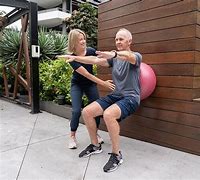When Should You See a Pelvic Health Physical Therapist?
Why Is Pelvic Floor Strength Important?
The pelvic floor has five main purposes, per Wright:
-
Sphincteric: The pelvic floor muscles contract to prevent leaking urine and feces and relax in order to eliminate them.
-
Support: These muscles act as a basket to support the pelvic organs, including the bladder, rectum and uterus.
-
Stability: They help stabilize your pelvis and hips.
-
Sexual: They help you achieve arousal and orgasm. Relaxing the pelvic floor is essential to allow for penetration.
-
Sump-pump: They move blood and lymph through the pelvis and toward the heart.
Symptoms of a Weak Pelvic Floor
When your pelvic floor muscles aren't up to snuff, they won't be able to perform the essential functions above. As a result, you'll likely feel as if something's amiss.
Here are some common symptoms of a weak pelvic floor, per Wright:
When Should You See a Pelvic Health Physical Therapist?
While home exercises can be helpful, they're also notoriously easy to mess up. Many people mistakenly squeeze the wrong muscles — like their abs or glutes — instead of their pelvic floor.
That's why if you suspect your pelvic floor is weak, it's best to see a pelvic health specialist who can make sure you're performing the exercises correctly.
"Pelvic health physical therapists have advanced training in treating conditions such as incontinence, pelvic organ prolapse, pregnancy/postpartum exercise, pregnancy-related pain, diastasis rectus abdominis, painful intercourse and pelvic pain conditions," Wright says. As specialists, they can properly assess your issue and develop an individualized treatment plan.
-
Accidentally leaking urine when you exercise, cough, sneeze or laugh
-
Having a strong urgency to urinate and not making it to the bathroom in time
-
Needing to urinate frequently (8+ times/day and/or more than once overnight)
-
A feeling of heaviness, drooping, bulging or discomfort in the vagina or rectum
-
Pain in the pelvic area and/or discomfort during sexual intercourse
How to Test if Your Pelvic Floor Muscles Are Strong
"Pelvic floor muscle strength is most accurately assessed with an internal vaginal examination conducted by a licensed physical therapist who specializes in pelvic health," Wright says.
However, there are two tests you can do at home to glean a general idea of your pelvic floor's muscle power.
1. Internal Vaginal Self-Assessment
-
Lie on your back with knees bent and one or two pillows supporting your head. Alternatively, you can lie on your side with a pillow between your knees for comfort.
-
Insert one clean index finger (with lubricant if you prefer) into the vaginal canal to the base of the middle knuckle.
-
Contract your pelvic floor (think about "stopping the flow of urine").
"A strong pelvic floor contraction will have a squeeze and an upward 'lift' where you feel some amount of tension when you try to remove your finger from the vagina," Wright says. "The ability to hold the lift for 10 seconds demonstrates good pelvic floor muscular endurance," she adds.
2. External Self-Assessment
-
Lie on your back with knees bent and one or two pillows supporting your head. Alternatively, you can lie on your side with a pillow between your knees for comfort.
-
Place your four fingers over your perineum (the area between the vaginal canal and the rectum).
-
Contract your pelvic floor as if you are stopping the flow of urine.
If your pelvic floor muscles are strong, "you should feel the area under your fingers lift and pull upward," Wright says. Also, "there should be no additional pressure toward your fingers if you are contracting correctly," she adds.
How to Strengthen Your Pelvic Floor
If you think your pelvic floor may be weak, Wright recommends trying one of the following pelvic floor-strengthening exercises:
1. Kegels
-
Start by lying on your back in a comfortable position.
-
Lift your pelvic floor as if you are stopping the flow of urine.
-
Start by contracting for 2 seconds and relaxing for 2 seconds. Aim for 3 sets of 10 to 15 repetitions and increase duration to 10-second holds.
-
If you find yourself fatiguing, try performing less repetitions, or perform each set at different times of the day, i.e. morning, afternoon and evening.
-
As this exercise gets easier, perform while sitting or standing.
2. Adductor Ball Squeeze
-
Lie on your back or side or sit in a chair with your feet on the floor and knees bent to 90 degrees.
-
Place a soccer ball, yoga block or thick pillow between the knees.
-
Squeeze the ball using your inner thighs (adductors) and think about contracting your pelvic floor simultaneously. Hold for 3 to 5 seconds.
-
Aim for 3 sets of 10 to 15 repetitions.
3. Bridge with Adductor Ball Squeeze
-
Lie on the floor with your knees bent, feet flat on the floor and palms facing down. Place a soccer ball, yoga block or thick pillow between the knees.
-
Squeeze the ball/yoga block between your knees. Contract your glutes and pelvic floor as you raise your hips off the ground. Your upper back and shoulders should stay resting on the ground and your knees, hips and shoulders should ideally form one straight line.
-
Aim for 2 to 3 sets of 10 to 15 repetitions.
When Should You See a Pelvic Health Physical Therapist?
While home exercises can be helpful, they're also notoriously easy to mess up. Many people mistakenly squeeze the wrong muscles — like their abs or glutes — instead of their pelvic floor.
That's why if you suspect your pelvic floor is weak, it's best to see a pelvic health specialist who can make sure you're performing the exercises correctly.
"Pelvic health physical therapists have advanced training in treating conditions such as incontinence, pelvic organ prolapse, pregnancy/postpartum exercise, pregnancy-related pain, diastasis rectus abdominis, painful intercourse and pelvic pain conditions," Wright says. As specialists, they can properly assess your issue and develop an individualized treatment plan.







































